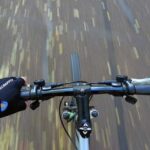Maintaining a good bike tire pressure is important as you’re always wanting the best performance from your bike. Regardless if you’re riding down winding roads, rocky terrain, or are participating in a race you need the best performance that your cycle can give you.
You’ve likely spent a good deal of time looking at ways to improve your ride; new tires, a better frame, improved gears, etc. This is all well and good, but you’re likely forgetting one key feature; tire pressure.
Often overlooked in favor of just getting new and fancy tires, keeping your tire pressure at a “sweet spot” can make the difference between a smooth ride and a very uncomfortable one.
Managing your tire pressure isn’t as easy as just pumping air in your bike and forgetting about it either. To find the “sweet spot” it takes time and effort, but thankfully not too much money.
Why Is Tyre Pressure Important?
The single biggest thing you can do for free to improve your bike performance; is to just maintain appropriate tire pressure. Your bike tire pressure affects your performance on two different levels; the grip on the ground ( helps with cycling ) and the rolling resistance that affects your speed.
Tire pressure, also called air pressure and tyre pressure, determines how much contact the tire has with the ground due in part to the amount of air in the tire.
Lesser the pressure more will be the contact surface and thus both grip and rolling resistance rise. Similarly more will be the pressure lesser will be the contact surface; thus less grip and rolling resistance.
For a good riding experience it is thus maintained somewhat in between. Since the total load, bike type and terrain have their own effects on tire; you should maintain tire pressure as per need.
This is measured in psi (Pound for Square Inch), and if the psi is low the rider will have more control and the ride is smoother, but turning is harder and the rims can be damaged. Higher pressure will mean faster speeds and a bumpy ride, but the tires are at risk of puncture.
There is more to tire pressure, of course, but this is just a quick summary so you can understand the importance and how a high-or-low pressure can affect your ride.

Does Bike Tire Pressure Affect Speed?
Your hybrid bike tire pressure is one of the biggest factor including weight, gear ratio, design and lubrication that affects your performance and speed on road and trails.
If you feel that your bike is running sluggish, check the tire pressure gauge before investing in new and expensive tires or taking it to the shop for repairs.
Tires with low pressure create more rolling resistance, which cuts back on speed.
If this is the case, why not just pump your tires with as much air as possible? Wouldn’t that keep it fast all the time? Although true, too much air in your tires can lead to a bike that can swerve out of control.
Softer tires might create more resistance, but they also grip the road. So a compromise should be made, and a psi of around 40 to 100 will be more than enough for your hybrid bike.
Making sure your tire pressure is correct is the simplest step to ensuring your bike is fast. It’s also one of the easiest and cheapest, as all you really need is a pressure gauge and an air pump.
What Is The Best Tire Pressure To Have?
With the basics covered, let’s see which tire pressure you should aim for. The truth is, there isn’t one that’s going to be “perfect”. Instead, you need to modify the air pressure in your tire to best fit your riding style.
As a general rule of thumb, regular road/commute/cruiser bike tires need 70 to 130 psi. Mountain tires require 25 to 45 psi, while hybrid tires need 40 to 90 psi.
You also need to take your weight into consideration along with the manufacture recommendations. The more you weigh, the more psi your tires need.
OF course, everyone has different opinions on which weight and psi work the best, so start at 100 psi and add either more air pressure or less depending on how well your bike is performing.
You’ll need to make some practice rides before determining which psi is right for you!
So make sure you’re filling the bike’s tire in the location you want to ride in or with the right weight if carrying heavy loads and writing down which psi works for you so you don’t forget!
What’s The Correct Tire Pressure for a Hybrid Bike?
There is no specific answer to this question of what’s the correct air pressure for your hybrid bikes tires. So what should be the pressure we should achieve? The manufacturer recommendation is to fill your hybrid tires somewhere in between 40 psi and 90 psi.
Some even go as further as to specify specific air pressure level marked on the tires. From my own experience the given pressure works well at lower weight.
But with heavier weight go for a little extra pressure than what marked on the tire. Check out this handy chart for the tire pressure range to follow ( in case you can’t find it on your bike tire/user manual ):
Tyre Size | 60 kg / 132 lbs | 85 kg / 187 lbs | 110 kg / 242 lbs |
700c Wheel | 80 psi | 85 psi | 90 psi |
26 inch Wheel | 70 psi | 75 psi | 80 psi |
24 inch Wheel | 60 psi | 65 psi | 70 psi |
20 inch Wheel | 45 psi | 55 psi | 65 psi |
As you have seen, hybrid bike tire pressure depends on a number of deciding factors. These includes the width of your tire, wheel size, bike type and your weight.
From the above chart we can say you need lesser pressure for smaller wheels. The effect of wheel size on pressure is more than the impact of your weight.
Good tire pressure is not some exact value. One should always keep his or her bike tire pressure at which they like to find the best riding experience for themselves.
What Happens if You Put Too Much Air in Your bike Tyre?
As a rule of thumb for a 20% increase in pressure you get around 10-12% increase in speed. Filling in more air into your tires reduce the contact area and thus reduces the rolling resistance. If you are bike have suddenly become too slow or feels hard to ride; its better you check your tire pressure.
If this is the case, why not just pump your tires with as much air as possible? Wouldn’t that keep it fast all the time? Although true, too much air in your tires can lead to a bike that can swerve out of control.
Adding more air reduce the area of contact between your tire and the ground. While for a majority of time reducing this area helps you gain in speed; bit if this goes further below you start to lack on the nice grip you need on a road and especially on gravel grounds and mountain trails.
Further there is the risk of tire explosion. But at what PSI will a tire explode? Ideally most bicycle tires explode at 2.5 times their rates pressure.
Which means a 700c wheel tire with 80 psi rated pressure will explode at 200 psi pressure. But since you never know the actual quality of the Tyre and where is it made; take it as 2 times for safety margin.
How Do You Check Your Tire Pressure?
There are a few ways to check on a bike tire pressure, and the easiest is a gauge. A gauge will give you an exact reading on the psi in your tires, and is a lifesaver when determining how much air pressure you need.
Most gauges have a long hose and connector piece to latch onto the air socket on your tire, and by pressing down you’ll have your reading. Easy, isn’t it?
However, constantly going back-and-forth between your air pump, the gauge, and letting out excess air can be quite troublesome. You can invest, and we recommend you do so, in an air pump with a built-in gauge.
This will save you the hassle of going back-and-forth between a pump and a gauge, and if honestly much more accurate when perfecting your psi.
Recommended: TOOLITIN Portable Bicycle Pump ( Check Its Price On Amazon )
However, these models tend to be more expensive and not everyone has the budget.
Now suppose you don’t have a gauge? How do you check your air pressure? The good news is you can check your tire pressure without a gauge, but it won’t be very accurate.
Pinch the sidewall of the tire between your thumb and forefinger, by doing so you can feel how thick or thin your tires are. This won’t give you a proper estimate, but a guess as to what the pressure is. Either you want the tires firmer, a higher psi, or looser with a lower psi.
How Do You Maintain Tire Pressure?
A bike tire pressure is not a one-and-done deal like replacing a seat or the gears. The air inside the tires will gradually leak out all the time, even if you don’t ride your bike often.
Essentially, the more you ride your bike the more air will be let out of your tires. So you’ll want to maintain the tire pressure constantly. How you got about this is up to you.
For many cyclists, they’ll check their tire pressure once a week. Either by a gauge or checking the pressure with their fingers. If they find that the pressure is too low for their liking.
They’ll add a few pumps of air and be on their way. For cyclists who ride almost every day or the more competitive types, they’ll check the pressure daily and adjust the pressure for any irregularities.
It very much depends on your riding style but checking pressure once a week will normally be all you need.
One thing it’s recommended you don’t do is fill the tire capacity to the maximum pressure as stated by the manufacturer. This might mean faster riding, yes, but puts you at greater risk of blowing your tire by accident.
Conclusion
Keeping your tire pressure at the optimal range is pivotal to getting the best performance from your bike.
While a pump and gauge may be rather expensive, although nothing compared to buying new parts for your bike, you should have them on hand.
Checking your tire pressure isn’t very hard or time-consuming, which is why you should never skip over this step like so many cyclists do.
Keeping your tire pressure at its best, even if it takes trial-and-error, is one of the fastest ways to improve your performance. Really, you have no excuse to not keep an eye on the pressure. Even if you check once a week, you’ll see a vast improvement in your performance by simply checking and adjusting the pressure.
Also Read,
7 Best Ways To Make Your Bike Faster
Are Tire Valve Caps Necessary? Truth About Bike Tire Valve Caps









Very helpful info